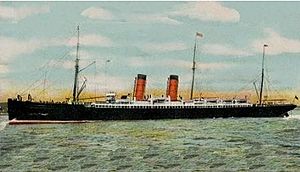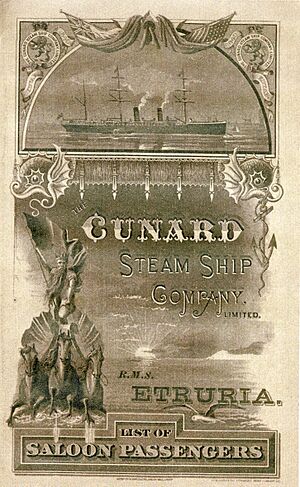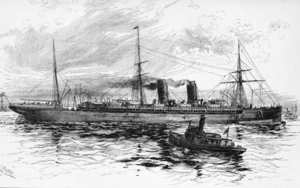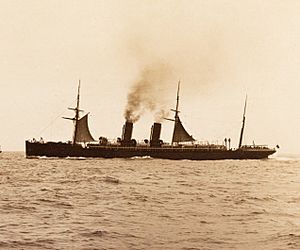RMS Etruria facts for kids

RMS Etruria
|
|
Quick facts for kids History |
|
|---|---|
| Name | Etruria |
| Namesake | Etruria |
| Owner | Cunard SS Co |
| Operator | Cunard SS Co |
| Port of registry | Liverpool |
| Route | Liverpool – Queenstown – New York |
| Ordered | 1883 |
| Builder | John Elder & Co, Glasgow |
| Yard number | 286 |
| Launched | 20 September 1884 |
| Completed | March 1885 |
| Maiden voyage | 25 April 1885 |
| Out of service | August 1908 |
| Identification | |
| Fate | Scrapped in Preston in 1910 |
| Notes | One of the last steamships to be fitted with auxiliary sails. |
| General characteristics | |
| Type | Ocean liner |
| Tonnage | 1884: 7,129 GRT, 3,258 NRT |
| Length | 501.6 ft (152.9 m) |
| Beam | 57.2 ft (17.4 m) |
| Depth | 38.2 ft (11.6 m) |
| Decks | 5 |
| Installed power | 1,559 NHP |
| Propulsion | 3-cylinder compound engine |
| Sail plan | barquentine |
| Speed | 19 knots (35 km/h) |
| Capacity |
|
The RMS Etruria was a huge ocean liner built in 1884 in Glasgow, Scotland. It was made for the Cunard Line, a famous shipping company. The Etruria and its sister ship, the Umbria, were special. They were the last big Cunard ships to still use sails, even though they had powerful engines. These ships were some of the biggest and fastest of their time. The Etruria was finished in March 1885 and started sailing between Liverpool and New York.
The Etruria had two big funnels, which made it look very powerful. It also had three tall steel masts with sails, like a type of sailing ship called a barquentine. The ship was also one of the first to have refrigeration equipment. But it was its single propeller that would cause some trouble later on.
The ship was designed in the fancy style of the Victorian era. The main rooms for first-class passengers had beautiful carved furniture. Heavy velvet curtains hung in all the rooms. These rooms and the first-class cabins were on the upper decks. There was also a music room, a smoke room for gentlemen, and separate dining rooms for first and second-class passengers. Second-class areas were comfortable and roomy for their time. The RMS Etruria could carry 550 first-class and 800 second-class passengers. Later, in 1892, this changed to 500 first-class, 160 second-class, and 800 third-class passengers.
Contents
Sailing the Atlantic Ocean
The Cunard company officially registered the Etruria in Liverpool. Its official number in the United Kingdom was 91187.
The Etruria was supposed to start its regular trips to New York from Liverpool in early 1885. But a problem came up when Russia threatened to invade Afghanistan. This delayed the Etruria's first trip across the Atlantic. On March 26, the Admiralty (the British navy) hired both the Etruria and Umbria. Luckily, the problem was solved quickly. The Etruria was released after a few days, but its sister ship stayed with the navy for six months.
On April 25, 1885, the Etruria finally made its first journey. It was led by Captain McMicken. The ship crossed the Atlantic, stopping at Queenstown (now Cobh) in Ireland. On its second trip, going from Liverpool to New York, the Etruria won the Blue Riband. This award goes to the fastest ship crossing the Atlantic.
On September 20, 1885, the Etruria was leaving New York. It was anchored in Lower New York Bay because of thick fog. Another cargo ship, the 4,276-ton Canada, crashed into the Etruria's right side. The Canada scraped along the Etruria, tearing off some of its ropes and equipment. Luckily, no one was hurt. Both ships continued their journeys.
Winston Churchill's Voyage
In November 1895, Winston Churchill was 20 years old and a lieutenant in the army. He got a few weeks off to visit Cuba. He wanted to see the Cuban War of Independence against Spain. He traveled from Liverpool to New York on the Etruria, arriving in New York on November 9. Three days later, he went on to Cuba. Churchill returned to Britain on December 21, 1895, again on the Etruria.
Collisions and Rescues
On August 8, 1896, the Etruria was involved in another collision. It sank a floating steam elevator called the Ceres in New York Bay. A steam elevator was a special boat used to load and unload grain from ships.
On December 10, 1897, the Etruria helped rescue the crew of the steamship Milfield. The Milfield was sinking in rough seas about 140 miles west of Fastnet Rock, a famous lighthouse.
Propeller Problems
On January 6, 1900, the Etruria left Liverpool. A week later, it arrived in New York. Engineers checked the ship and found cracks in its propeller shaft. This shaft connects the engine to the propeller. The sister ship, Umbria, had a propeller shaft break at sea in 1893. To avoid the same problem, the Etruria had to stay at the pier. A new shaft had to be shipped from Britain. After the new shaft was put in, the ship left New York on February 17.
In 1900, the Etruria kept sailing the North Atlantic. Meanwhile, the Umbria was used to carry soldiers during the Boer War in South Africa. By July 1900, both sister ships were back on their regular Atlantic route.
In 1901, the Etruria and its sister ship were given wireless telegraphy equipment. This allowed them to send messages using radio waves. On February 22, 1902, the Etruria left New York. It was supposed to arrive in Queenstown on March 1. On February 26, it radioed the Umbria to pass on messages for one of its passengers. However, that evening, its propeller shaft broke again. This left the ship drifting in the ocean.
The Etruria tried to radio the Umbria again to report its problem, but it couldn't. Back then, many ships didn't have people listening to the radio 24 hours a day. Finally, the Etruria got the attention of the ship William Cliff by firing distress rockets. The William Cliff came to help and stayed with the Etruria all night. The crew tried to fix the shaft. Then, the Etruria put up its sails, and the William Cliff started to tow it. They headed for Horta, in the Azores islands, which were 500 miles away.
The Etruria arrived in the Azores on Sunday, March 9. On March 15, its passengers and mail were moved to another ship, the Elbe. It took until summer 1902 for the Etruria to be repaired and back in service. But in October, after a very rough Atlantic trip, its propeller shaft showed serious cracks again. The ship was taken out of service and waited in New York for yet another new shaft. It finally sailed home on November 1. The year 1902 was a very difficult one for the ship.
More Bad Luck
On February 28, 1903, the Etruria was leaving New York when it ran aground. It got stuck on sand and mud in the entrance to Gedney Channel. Later that same day, it was pulled free. No damage was found, and it continued its trip to Liverpool.
On October 10, 1903, the Etruria was only four hours out of New York. At 2:30 PM, a giant rogue wave hit the ship. The wave was reported to be at least 50 feet high. It struck the ship on its left side. The wave washed away part of the front bridge and smashed the guardrail posts. Several first-class passengers were sitting in deck chairs near the bridge. They were hit by the full force of the water. One passenger, a Canadian, was badly hurt and sadly died. Several other passengers were also injured.
In January 1907, two of the Etruria's crew members died. They were trying to secure the ship's anchor in very rough weather during a trip to the west.
The End of the Etruria's Journey
By 1908, the Etruria and its sister ship were 23 years old. New, more advanced ships were being built. The famous RMS Lusitania and RMS Mauretania were almost ready to sail.
On Wednesday, August 26, 1908, the RMS Etruria was backing away from its pier in Liverpool. It was going to anchor where passengers would get on board. A hopper barge (a boat used to carry sand or gravel) crossing the Mersey river came too close. The Etruria violently rammed it. The Etruria's rudder and propeller were pushed deep into the hopper, almost cutting it in half. However, being stuck on the Etrurias propeller stopped the hopper from sinking. Both ships drifted helplessly in the Mersey. The hopper was then crushed against the landing stage. This accident ended the hopper's life and also the Etrurias career.
The Etrurias propeller, rudder, and steering system were badly damaged. Its next trip to New York had to be canceled. The Etrurias passengers stayed in hotels and then caught the Umbria later that week. The Etruria was taken to a dock for temporary repairs.
It never crossed the Atlantic again. After spending time stored at Birkenhead, it was finally sold for about £16,750 in October 1909. On October 10, 1910, a tugboat named Black Cock towed the Etruria to its final stop in Preston, Lancashire. There, it was taken apart for scrap metal. Its sale for scrap was announced in November 1909.
The Blue Riband Award
The Blue Riband was an unofficial award for the fastest passenger ship to cross the Atlantic Ocean. The Etruria won this award multiple times.
| Prices of passage aboard Etruria, May 1895 | ||||||||||
|---|---|---|---|---|---|---|---|---|---|---|
| From Pier 40, North River, foot of Clarkson Street, City of New York | ||||||||||
| Every Saturday, New York – Queenstown – Liverpool | ||||||||||
| 1st Class | 1st Class | 1st Class | 1st Class Return | 1st Class Return | 1st Class Return | 2nd Class Cabin | 2nd Class Cabin | 2nd Class Cabin Return | 2nd Class Cabin Return | Under 1 Year old |
| $75 | $90 | $175 | $125 | $150 | $315 | $40 | $45 | $75 | $85 | Free outward |
| Records of RMS Umbria & RMS Etruria | |||||||
|---|---|---|---|---|---|---|---|
| The Blue Riband of the North Atlantic | |||||||
| Westbound | |||||||
| Steamship | Date | Line | From | To | Nautical Miles | Days/Hours/Minutes | Knots |
| RMS Etruria | 1885 (16/8- 22/8) | Cunard | Queenstown | Sandy Hook | 2801 | 6/5/31 | 18.73 |
| RMS Umbria | 1887 (29/5-4/6) | Cunard | Queenstown | Sandy Hook | 2848 | 6/4/12 | 19.22 |
| RMS Etruria | 1888 (27/5-2/6) | Cunard | Queenstown | Sandy Hook | 2854 | 6/1/55 | 19.56 |
| Eastbound | |||||||
| Steamship | Date | Line | From | To | Nautical Miles | Days/Hours/Minute | Knots |
| Etruria | 1885 (1/8-7/8) | Cunard | Sandy Hook | Queenstown | 2822 | 6/9/0 | 18.44 |
| Etruria | 1888 (7/7-14/7) | Cunard | Sandy Hook | Queenstown | 2981 | 6/4/50 | 19.36 |
Images for kids








